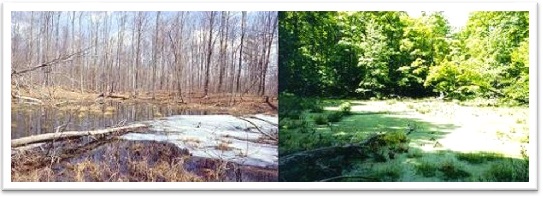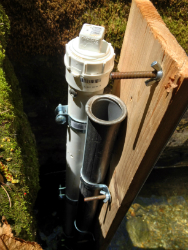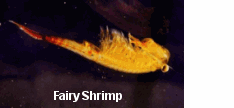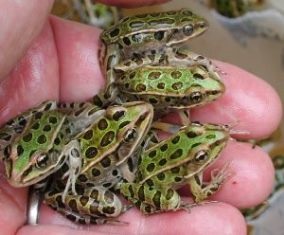
The Watershed Management Division participates in “special studies” when the need arises, such as:
- EPA Regional Monitoring Network to Detect Climate Change Effects in Stream Ecosystems
- Vernal Pool project
- Malformed Frog project
- Other past and ongoing efforts
EPA Regional Monitoring Network to Detect Climate Change Effects in Stream Ecosystems
 The Monitoring, Assessment and Planning Program is partnering with the U.S. EPA and other New England states to establish Regional Monitoring Networks (RMNs) at which biological, thermal, and hydrologic data will be collected from freshwater wadeable streams to quantify and monitor changes in baseline condition, including climate change effects. The need for RMNs stems from the lack of long-term, contemporaneous biological, thermal, and hydrologic data, particularly at minimally disturbed sites. Data collected at RMNs will be used to: detect temporal trends; investigate relationships between biological, thermal, and hydrologic data; explore ecosystem responses and recovery from extreme weather events; test hypotheses and predictive models related to climate change; and quantify natural variability.
The Monitoring, Assessment and Planning Program is partnering with the U.S. EPA and other New England states to establish Regional Monitoring Networks (RMNs) at which biological, thermal, and hydrologic data will be collected from freshwater wadeable streams to quantify and monitor changes in baseline condition, including climate change effects. The need for RMNs stems from the lack of long-term, contemporaneous biological, thermal, and hydrologic data, particularly at minimally disturbed sites. Data collected at RMNs will be used to: detect temporal trends; investigate relationships between biological, thermal, and hydrologic data; explore ecosystem responses and recovery from extreme weather events; test hypotheses and predictive models related to climate change; and quantify natural variability.
An EPA report describing the program was released in February 2016: Regional Monitoring Networks (RMN) to Detect Changing Baselines in Freshwater Wadeable Streams.
Vernal Pool Project
The Vermont Wetlands Bioassessment Project, aka, the Vernal Pool Project, was initiated as part of a New England-wide effort to develop and implement biological assessment and monitoring programs for wetlands. The Vermont Department of Environmental Conservation (VT DEC) and the Vermont Wildlife Diversity Program began working collaboratively to develop methods for the classification and bioassessment of two wetland types: seasonal pools (vernal pools) and northern white cedar swamps.
The vernal pool study was designed by VT DEC Monitoring and Assessment Program (MAP) to assess the natural variability in the biological, chemical, and physical make-up of reference-quality vernal pools in Vermont in order to provide a reference framework from which future vernal pool bioassessment programs can be developed; to develop a protocol for standardized sampling of macroinvertebrates, vegetation, and water chemistry in vernal pools; to develop a preliminary classification system for reference quality vernal pools that identifies important indicators if ecological health; begin to identify the range of variability of identified indicators within the reference conditions well as factors that influence that variability.
During 1999 and 2000, 28 vernal pools were sampled in Vermont. The data has been compiled and analyzed. Click on a link below to download a section of the report:
- Vernal Pool Report

- Executive Summary
- Appendix A: Site Reports A-G
- Appendix A: Site Reports H-Z
- Appendix B: Data Tables
- Appendices C & D: Water Chemistry & Cedar Swamp Sites
Biologists in MAP have worked extensively on the development of biological criteria for wadeable streams and lakes using various biological assemblages from those environments, with emphasis on aquatic macroinvertebrate and fish assemblages. In addition, the Department of Environmental Conservation has developed a classification system, based on biological assemblage attributes, for rivers and lakes.
For information on northern white cedar swamps contact the Vermont Wildlife Diversity Program.
For more information on vernal pools contact the Watershed Managment Division's Monitoring, Assessment and Planning Program.
Malformed Frogs 
A summary of the malformed frog work conducted in Vermont from 1996-2003 and its findings can be found here:
- Vermont Malformed Frog Research project
- Executive Summary of Investigations into the Causes of Amphibian Malformations in the Lake Champlain Basin of New England
- Investigations into the Causes of Amphibian Malformations in the Lake Champlain Basin of New England (full report)
Other past and ongoing efforts
- BMP Effectiveness Monitoring at Englesby Brook and Little Otter Creek
- Kingdom Wind Biological Monitoring Results Summary
- Lake Champlain Basin Agricultural Watersheds Monitoring Project
- Using Host-Associated Genetic Markers to Investigate Sources of Fecal Contamination in Two Vermont Streams
- Monitor the effects on non-target fish and macroinvertebrates in those rivers subject to lampricide (TFM) treatments.
- Monitor the effectiveness of SONAR® chemical treatment on Eurasian watermilfoil and non-target aquatic biota on two lakes in 2000.
- Monitor the effects on both target and non-target organisms of copper sulfate treatments to control the snails partially responsible for swimmer's itch in a pond.
For more information about monitoring studies, contact a member of the MAP staff.
